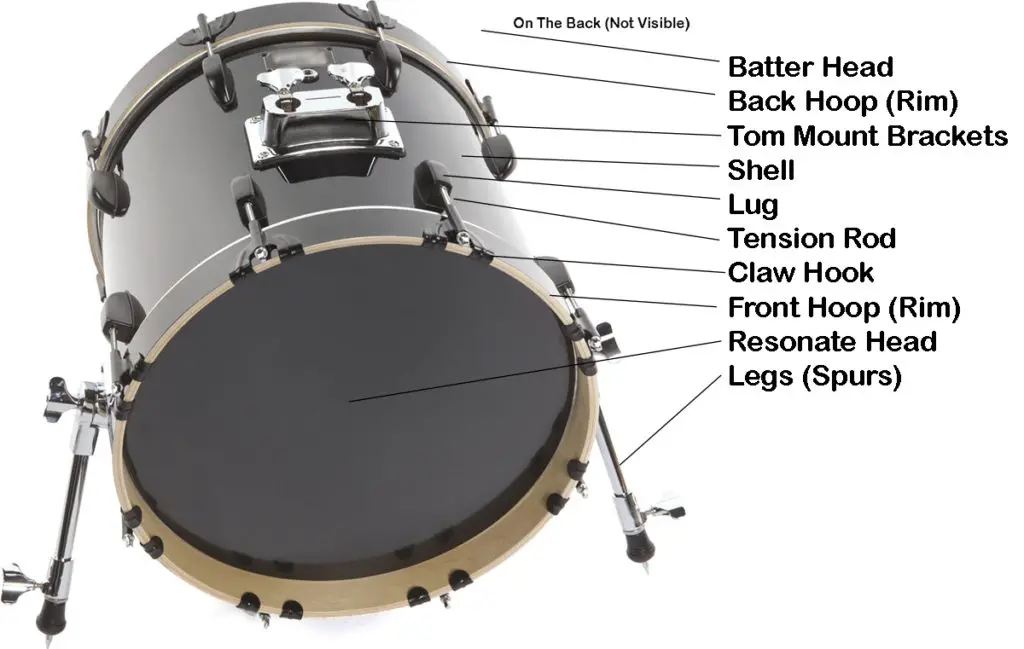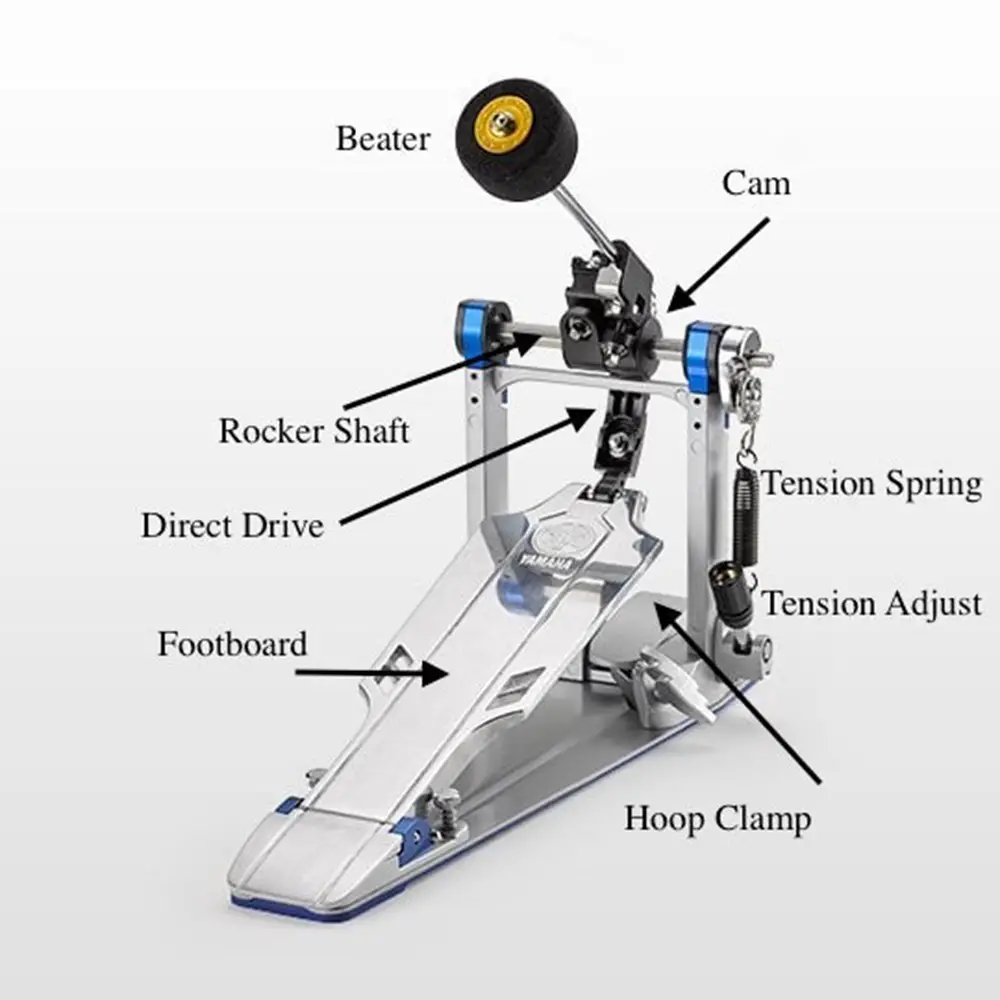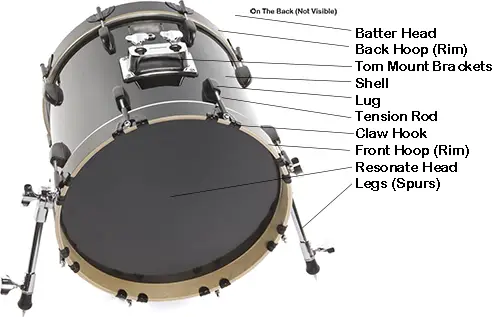The drum set is composed of many parts, such as the bass drum, snare drum, tom-tom, floor tom, and various cymbals. Bass drums and kick pedals are two crucial parts of a drum set, and you will hardly find a drumset without them.
A bass drum is used to provide the “bottom” or low-pitched sound for a song, while a drum pedal supplies the method to strike the bass drum.
If you’re curious about what part does what, or if you’re just starting out on your quest for knowledge about percussion instruments, then this article is for you!

Parts of the Bass Drum
- Shell
- Front Hoop (Rim)
- Back Hoop (Rim)
- Resonate Head
- Batter Head
- Supporting Legs (Spurs)
- Lug
- Tension Rod (Screw)
- Claw Hook (Counter Hoop)
- Tom Mount Brackets
Shell:
The shell is the main body of the drum that holds all of the parts together. It can be made out of wood or metal. The material used determines in part how much resonance a bass drum will have and also its weight.
Hoop (Rim):
The rim, or hoop, is the outside edge of a drum that holds the drum head in place. The front hoop is the one that faces the audience, and the back hoop is the one that is closest to the drummer.
It is common to use wood hoops on bass drums to emphasize the low range, although metal hoops still sound good and are more affordable. The toms and snare typically have metal rims.
Head:
The head is the part of the drum that gets struck and makes noise.
The batter head is the head that gets struck by the beater. The resonate head, reso head for short, is the one that does not get hit and produces sound as it vibrates with the batter head is struck.
Supporting Legs (Spurs):
The legs are thin metal bars that are attached to the bottom of the drum. They stabilize the drum and can help keep it from sliding. Legs can be adjusted to change the angle at which a drummer strikes their bass drum.
Tip: Keeping the drum off the floor is beneficial since it allows for more tone from the drum and does not dampen it. That said, keep it level, not with a raised front.
Because the pedal holds the batter hoop in place, you bend the batter hoop if you raise the front of the drum.
If you raise only the front of the drum, the pedal will cause the front hoop to bend and warp.
The tension on one half of the head is greater than the other, causing it to be out of tune with itself and raising the drum’s pitch. Usually not what you want.
Taking your pedal and putting it on the front hoop is the easiest way to keep your bass drum level. Adjust the spurs until they rest on the floor when the pedal is locked in place. Then reinstall the pedal on the batter hoop and you’ve got your drum off the floor but level.
Related Content: Why Do Drummers Use Rugs? What Does a Drum Rug Do?
Lug:
The lugs are small metal tubes attached to the drum’s shell, which act as attachment points for the tension rods.
Tension Rod:
A bolt for placing and modifying the tension of the drum heads. The tension rod provides the way to tighten or loosen the bass drum head.
Claw Hook (Counter Hoop):
Hooks are metal rings that attach a drumhead to the drum shell.
Tension rods go through holes in the hooks and screw into the lugs. The tension rod places pressure on the hook as it is tightened. As you tighten the tension rods, the counter hoop pushes down on the outside of the drumhead and raises the pitch. Conversely, if you loosen the tension rods, the counter hoop relaxes on the drumhead and lowers the pitch.
Related Content: What Does Putting a Pillow In a Kick Drum Do?
Tom Mount Brackets:
Mounts are fixed to the drum shell and used for attaching tom-toms.
If you are interested in learning a little more, Yamaha has a series on parts of the drum. Here is the section on the bass drum: Click Here
Parts of the Drum Kick Pedal
- Footboard
- Drive Chain (or Belt)
- Cam
- Cam Shaft
- Pedal Spring
- Toe Clamp
- Beater
- Beater Head
- Floor Spikes (Spurs)

Image Credit: https://hub.yamaha.com/wp-content/uploads/2020/03/Components_FootPedalFig1.jpg
Related Content: What Is the Difference Between a Junior Drum Set and a Normal One?
Footboard:
The physical part where you press down with your foot to create the motion that will result in a bass drum beat.
Drive Chain (or Belt/Strap):
The drive chain is the mechanism that connects your footboard to your beater.
Chains are heavier, so they’ll have a heavier feel when playing. They transfer more energy due to their weight, so they will typically be best for someone who wants a more powerful sound.
A belt, or strap, is a common alternative to a chain.
Straps are quieter, and they don’t rust or stretch. With cutting-edge materials, the problems of stretching and breaking (such as old leather) have been addressed. Strap pedals play lighter and tend to have a “quicker” feel.
A single chain pedal is an excellent compromise between a lighter, more responsive strap and a heavier-driving double chain.
Cam:
The cam is the part that is attached to the camshaft and holds the beater in place.
Camshaft:
The rod that rotates when you press down or release the pedal. It connects the footboard and the beater and links to the pedal spring.
Pedal Spring:
The spring holds tension on the pedal so that the pedal and beater return to their starting position when you release your foot. The tension of the spring can be adjusted to your preference.
Toe Clamp:
The toe clamp connected the pedal to the lip of the bass drum.
Beater:
The beater is the arm that extends out from the cam and holds the beater head.
Beater Head:
The beater head is the part that strikes the drum head. Beater heads are usually made of felt, but plastic is another cheaper alternative.
Related Content: What Does Putting Tape on Drums Do?
Floor Spikes (Spurs):
Floor spikes extend out from the bottom of the drum pedal to prevent the pedal from sliding as you play.
The spikes, or spurs, are adjustable such that you can make it, so they don’t extend out from the bottom of the pedal. This is useful when you don’t want the spikes to scratch the floor.
If you are interested in learning a little more about drum pedals, Yamaha has another section on the parts of the drum. Here is the section on foot pedals: Click Here
Conclusion
Parts of a bass drum and parts of a pedal are essential to know to set up your instrument correctly, understand how it works, and create the sound you desire. In this article, we have covered the basics of each part so that you can work on becoming a drum expert!
Parts of a bass drum include the lugs, tension rods, claw hooks (counter hoops), tom mount brackets, and footboards. Parts of a drum pedal include the drive chain or belt, cam, camshaft, pedal spring, toe clamp, beater head, floor spikes (spurs), and footboard. Adjusting the spurs on your pedal can help keep it in place while playing.
Of course, there are various parts, add-ons, and accessories. In this article, we’ve outlined the most common parts of the bass drum and explained how each part works together to create that signature bass drum sound.


